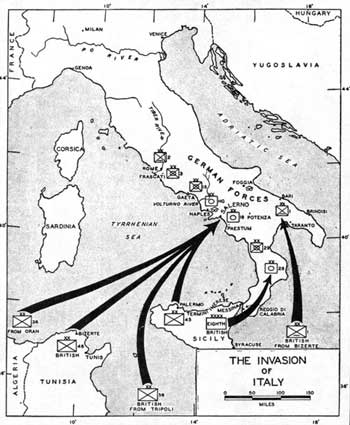World War II: War on the Mediterranean Front
World War II: War on the Mediterranean Front
 The Italian Campaign of World War II was the name of Allied operations in and around Italy, from 1943 to the end of the war in Europe. Joint Allied Forces Headquarters AFHQ was operationally responsible for all Allied land forces in the Mediterranean theatre, and it planned and commanded the invasion of Sicily and the campaign on the Italian mainland until the surrender of German forces in Italy in May 1945.
The Italian Campaign of World War II was the name of Allied operations in and around Italy, from 1943 to the end of the war in Europe. Joint Allied Forces Headquarters AFHQ was operationally responsible for all Allied land forces in the Mediterranean theatre, and it planned and commanded the invasion of Sicily and the campaign on the Italian mainland until the surrender of German forces in Italy in May 1945.
It is estimated that between September 1943 and April 1945 some 60,000 Allied and 50,000 German soldiers died in Italy.Total Allied casualties during the campaign totaled about 320,000 and the corresponding Axis figure (excluding those involved in the final surrender) was over 658,000. No campaign in Western Europe cost more than the Italian campaign in terms of lives lost and wounds suffered by infantry forces.
Even prior to victory in the North African Campaign, there was disagreement between the Allies on the best strategy to defeat the Axis. The British, especially Winston Churchill, advocated their traditional naval-based peripheral strategy. Even with a large army, but greater naval power, the traditional British strategy against a continental enemy was to fight as part of a coalition and mount small peripheral operations designed to gradually weaken the enemy. The United States, with an even larger army, favored a more direct strategy of fighting the main force of the German army in northern Europe. The ability to launch such a campaign depended on first winning the Battle of the Atlantic.
The strategic disagreement was fierce, with the US service chiefs arguing for an invasion of France as early as possible, while their British counterparts advocated a Mediterranean strategy. The American staff believed that a full-scale invasion of France as soon as possible was necessary to end the war in Europe, and that no operations should be undertaken which might delay that effort. The British argued that the presence of large numbers of troops trained for amphibious landings in the Mediterranean made a limited-scale invasion possible and useful.
Eventually the US and British political leadership made the decision to commit to an invasion of France in early 1944, but with a lower-priority Italian campaign reflecting Roosevelt's desire that to keep U.S. troops active in the European theater during 1943 and his attraction to the idea of eliminating Italy from the war. It was hoped that an invasion would knock them out of the war, or provide at least a major propaganda blow. The elimination of Italy as an enemy would also enable Allied naval forces, principally the Royal Navy, to completely dominate the Mediterranean Sea, massively improving communications with Egypt, the Far East, the Middle East, and India. It would also mean that the Germans would have to transfer troops from the Eastern Front to defend Italy and the entire southern coast of France, thus aiding the Soviets. The Italians would also withdraw their troops from the Soviet Union to defend Italy.
|







 The Italian Campaign of World War II was the name of Allied operations in and around Italy, from 1943 to the end of the war in Europe. Joint Allied Forces Headquarters AFHQ was operationally responsible for all Allied land forces in the Mediterranean theatre, and it planned and commanded the invasion of Sicily and the campaign on the Italian mainland until the surrender of German forces in Italy in May 1945.
The Italian Campaign of World War II was the name of Allied operations in and around Italy, from 1943 to the end of the war in Europe. Joint Allied Forces Headquarters AFHQ was operationally responsible for all Allied land forces in the Mediterranean theatre, and it planned and commanded the invasion of Sicily and the campaign on the Italian mainland until the surrender of German forces in Italy in May 1945.